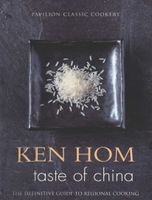Advertisement
Bean Thread (transparent) Noodles
By Ken Hom
Published 1990
These noodles, also called cellophane noodles, are made from ground mung beans and not from a grain flour. Freshly made ones can sometimes be seen in China, fluttering in the breeze on lines like drying clothes. They are available dried, and are very fine and white. Easy to recognise, packed in their neat, plastic-wrapped bundles, they are stocked by most Chinese markets and some supermarkets. They are never served on their own, but are added to soups or braised dishes or are deep-fried and used as a garnish. They must be soaked in warm water for about 5 minutes before use. As they are rather long you might find it easier to cut them into shorter lengths after soaking. If you are frying them, they do not need soaking beforehand but do need to be separated. A good technique for separating the strands is to pull them apart while holding them in a large paper bag which stops them from flying all over the place.


